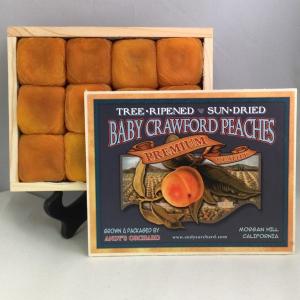Baby Crawford peaches have rich flavor, aroma
Babe or baby means smaller than usual. Baby grand pianos measure 5 feet, not the 7 feet of concert pianos. Baby Bentley is the smaller, sportier Rolls-Royce.
Along these lines, the Curtiss Candy Company in 1921 introduced a candy bar named after Grover Cleveland's daughter and called it the Baby Ruth. Odd name, Baby Ruth, given that the real “Baby Ruth” was dead for several years before her namesake candy bar was born. It was widely thought that with the change of a single letter, the Baby Ruth candy bar could ride Babe Ruth's fame without paying royalties. It worked, and annual sales reached $12 million. When Babe Ruth tried to register his own “Ruth’s Home Run Candy,” the Curtiss Candy Company sued for copyright infringement. The Babe lost, and today we have Baby Ruth, not Babe Ruth candy bars.
There's even a babe or baby in the garden. The baby in the name tells us that Baby Crawford Peach (Prunus persica) are not large peaches. But these small golden babies have what may be the most intensely peach flavor of any yellow freestone peach. The juicy flesh is firm yet fine-textured and with a rich aroma. They ripen mid-season.
The Baby Crawford peach dates back to the early 20th century but was only rediscovered as a sample in a University of California evaluation of peaches for drying. Hardy in USDA Zones 5-9, trees should bear fruit in just one to three years. Expect a mature height of 12 to 16 feet.
Peaches adapt to almost any soil, as long as it is well drained. Peaches are self-fertile, so you will get fruit even if you only have a single tree. Plant peaches in full sun, and away from low-lying areas. For bare-root peach trees, soak the roots in water for 12 to 24 hours, then plant immediately. Be sure to avoid low spots, because frost can more easily settle there and destroy your peaches.
If you are planting container-grown trees, be sure to untangle any circling roots. Plant peach trees in holes slightly deeper and wider than the existing root ball. Place the tree on top of a slight mound of soil in the planting hole and fan the roots out. Space standard-size peach trees 15 to 20 feet apart, while dwarf trees can be as close as 10 or 12 feet apart.
Standard peach trees need heavy pruning to yield well. Because peaches bear fruit only on new wood, cut back heavily after harvesting. Try to prune so the tree has a vase shape with an open center. Peaches also do well when shaped on a trellis or against a wall.
The one downside of peaches is a disease called leaf curl. Even peach trees known to be resistant to the disease often get some leaf curl during the first few years. You can control leaf curl with a lime sulfur spray used just as the flower buds show color. Reapply this spray again three weeks later.
These heirloom peach trees yield quickly, stay naturally short and are self-fertile, so you can plant just one. It's easy to grow heirloom Baby Crawford Peaches. Just take baby steps.
























































